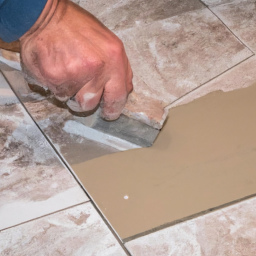Are you wondering if ceramic tile is eco-friendly? Look no further! This article will provide you with a comprehensive analysis of the environmental impact of ceramic tile production, as well as the benefits of using it in sustainable building. You’ll learn about life cycle analysis, eco-friendly installation methods, and recycling options for ceramic tile. We’ll even compare ceramic tile to other flooring options in terms of sustainability. Get ready to make informed choices for a greener future!
Environmental Impact of Ceramic Tile Production

You’ll be glad to know that the environmental impact of ceramic tile production is relatively low. When it comes to sustainability, ceramic tiles are considered a favorable choice for flooring and wall covering materials. One key aspect that contributes to their eco-friendliness is the manufacturing process itself.
Ceramic tile manufacturing involves several stages, including raw material extraction, processing, glazing, and firing. The sustainability of this process lies in its efficient use of resources and minimal waste generation. For instance, many manufacturers have implemented closed-loop water recycling systems to minimize water consumption during production.
Furthermore, the carbon footprint of ceramic tile production is relatively low compared to other building materials. According to studies conducted by the Tile Council of North America (TCNA), the energy required for ceramic tile production is significantly lower than that needed for alternative products like carpet or vinyl flooring.
Additionally, advancements in technology have led to more sustainable practices within the industry. Some manufacturers now utilize renewable energy sources such as solar power in their production facilities, further reducing their carbon emissions.
Overall, the environmental impact of ceramic tile production is relatively low due to sustainable manufacturing practices and reduced carbon footprint. Choosing ceramic tiles for your home not only provides an aesthetically pleasing option but also supports a greener future.
Benefits of Using Ceramic Tile in Sustainable Building

When selecting materials for sustainable building, it’s important to consider the advantages of using ceramic tiles. Ceramic tiles offer numerous benefits that make them an ideal choice for sustainable design and energy efficiency.
Firstly, ceramic tiles are made from natural materials such as clay, sand, and minerals. This means that they are non-toxic and do not release harmful chemicals into the environment. Additionally, the production process of ceramic tiles requires less energy compared to other types of flooring materials like vinyl or carpet. This makes ceramic tiles a more energy-efficient option.
Furthermore, ceramic tiles have a long lifespan, which contributes to their sustainability. They are highly durable and can withstand heavy foot traffic without losing their quality or appearance. Unlike other flooring options that need frequent replacement due to wear and tear, ceramic tiles can last for decades with proper maintenance.
In terms of energy efficiency, ceramic tiles have excellent thermal properties. They help in keeping spaces cool during hot summers by reflecting heat away from the surface. This reduces the need for air conditioning and ultimately leads to lower energy consumption.
Life Cycle Analysis of Ceramic Tile

To fully understand the sustainability of using ceramic tiles in construction, it’s important to analyze the life cycle of this material. A comprehensive carbon footprint analysis reveals that ceramic tiles have a relatively low environmental impact compared to other flooring options. The production phase is where most of the energy is consumed and greenhouse gas emissions are generated. However, advancements in technology have significantly reduced the energy consumption during manufacturing. Additionally, ceramic tiles are durable and long-lasting, which means they require less frequent replacement compared to other materials like carpet or vinyl. This contributes to their overall energy efficiency throughout their lifespan.
Furthermore, when considering the entire life cycle of ceramic tiles, from raw material extraction to disposal or recycling, they offer numerous environmental benefits. They are made from abundant natural resources such as clay and sand, reducing dependence on non-renewable materials. Moreover, their inert nature makes them non-toxic and safe for indoor air quality.
In terms of end-of-life management, ceramic tiles can be recycled into new products or crushed into aggregate for use in road construction. Recycling helps reduce waste and conserves resources while minimizing the need for additional raw material extraction.
Eco-Friendly Installation Methods for Ceramic Tile

Using adhesive made from recycled materials can be a sustainable option for installing your ceramic tiles. Not only does it reduce waste by repurposing discarded materials, but it also helps to minimize the environmental impact of your tile installation. Sustainable grout options further contribute to eco-friendly installation methods. Look for grouts that are made from recycled content or have low VOC (volatile organic compound) emissions. These options are not only better for the environment, but they also promote healthier indoor air quality in your home.
Another aspect of eco-friendly ceramic tile installation is energy efficient tile cutting techniques. Traditional tile cutting methods often involve using water-cooled saws that consume significant amounts of electricity and water resources. However, there are now more energy-efficient alternatives available on the market. For instance, some manufacturers offer electric tile cutters that use less energy and eliminate the need for excessive water usage.
Recycling and Disposal of Ceramic Tile

Recycling and disposing of your used tiles responsibly is crucial for minimizing waste and reducing the environmental impact of your home improvement projects. When it comes to recycling ceramic tiles, there are a few methods you can consider.
One option is to donate your old tiles to organizations or individuals who can reuse them in their own projects. This not only reduces waste but also helps others save money on purchasing new materials. Another method is to recycle the tiles through specialized recycling facilities that accept construction and demolition debris. These facilities have processes in place to separate the ceramic material from other contaminants and recycle it into new products.
It’s important to note that the availability of recycling options may vary depending on your location. Some areas have specific programs or facilities dedicated to tile recycling, while others may offer more general construction waste recycling services.
In addition to considering recycling methods, it’s also essential to be aware of any environmental regulations related to tile disposal in your area. Certain jurisdictions may have restrictions on how tiles should be disposed of due to concerns about hazardous materials or landfill capacity. By following these regulations, you can ensure that you are minimizing your impact on the environment and complying with local laws.
Overall, taking the time and effort to recycle or dispose of your used tiles responsibly is an important step towards creating a more sustainable home improvement project.
Comparing Ceramic Tile to Other Flooring Options in Terms of Sustainability

When it comes to choosing flooring options with sustainability in mind, you should consider how different materials compare. In terms of energy efficiency and carbon footprint, ceramic tile is a great choice. Ceramic tile is made from natural materials such as clay and sand, which are abundant and renewable resources. The production process for ceramic tile requires less energy compared to other flooring options like carpet or vinyl. Additionally, ceramic tile has a long lifespan and is highly durable, reducing the need for frequent replacement.
In terms of its carbon footprint, ceramic tile performs well. Its production process emits lower levels of greenhouse gases compared to other flooring materials. Furthermore, the durability of ceramic tile means that it does not need to be replaced frequently, reducing waste and landfill contributions.
Another advantage of ceramic tile is its ability to retain heat during colder months. This can help reduce heating costs in your home by providing insulation and retaining warmth.
While there are many sustainable flooring options available on the market today, ceramic tile stands out due to its energy efficiency and low carbon footprint. By choosing ceramic tile for your floors, you can contribute towards a more sustainable future while still enjoying a beautiful and durable flooring option in your home or business space.
Frequently Asked Questions
How Do the Raw Materials Used in Ceramic Tile Production Affect the Environment?
When considering the environmental impact of ceramic tile production, it is important to examine how the raw materials used affect the environment. The sourcing of these materials plays a significant role in determining their environmental footprint. The extraction and processing of raw materials such as clay, sand, and minerals can contribute to habitat destruction, water pollution, and carbon emissions. Understanding the implications of raw material sourcing is crucial in assessing the overall eco-friendliness of ceramic tiles.
Is It Possible to Recycle Old Ceramic Tiles?
Yes, it is possible to recycle old ceramic tiles. Recycling methods for ceramic tiles involve crushing them into smaller pieces and then using those pieces as an aggregate in new tile production or other construction materials. This reduces the need for extracting new raw materials and minimizes the environmental impact of mining activities. By recycling old ceramic tiles, we can contribute to a more sustainable and eco-friendly approach to tile production and waste management.
Are There Any Health Risks Associated With the Production or Use of Ceramic Tiles?
When considering the health risks and production impact of ceramic tiles, it’s essential to gather thorough research and evidence. The manufacturing process of ceramic tiles involves the use of various chemicals, such as glazes and pigments, which can potentially release harmful substances. These substances may lead to respiratory issues or skin irritation for workers involved in the production. Additionally, the extraction of raw materials and energy consumption during manufacturing can have environmental consequences.
Can Ceramic Tiles Be Installed Using Eco-Friendly Adhesives and Grouts?
When it comes to installing ceramic tiles, there are definitely eco-friendly options available for the adhesives and grouts you use. You can choose from a range of sustainable adhesives that are made from natural materials and have low VOC emissions. Additionally, there are grout options that are made with recycled content or are biodegradable. By opting for these eco-friendly alternatives, you can ensure that your ceramic tile installation is not only stylish but also environmentally conscious.
What Are the Long-Term Effects of Ceramic Tile Usage on Indoor Air Quality?
Ceramic tile emissions can have long-term effects on indoor air quality. It is important to consider the potential for indoor air pollution when using ceramic tiles in your space. These emissions can contribute to volatile organic compounds (VOCs) and other pollutants that may be harmful to your health. To ensure better air quality, it is recommended to choose low-emission ceramic tiles and use proper ventilation systems in areas where these tiles are installed.
Conclusion
In conclusion, if you are looking for an eco-friendly flooring option, ceramic tile is a great choice. Its production has a relatively low environmental impact compared to other flooring materials. Additionally, ceramic tile is durable and long-lasting, making it a sustainable option for building projects. Life cycle analysis shows that ceramic tile has a positive impact on the environment over its lifespan. By using eco-friendly installation methods and considering recycling options, you can further enhance the sustainability of ceramic tile. So why not choose ceramic tile and contribute to a greener future?